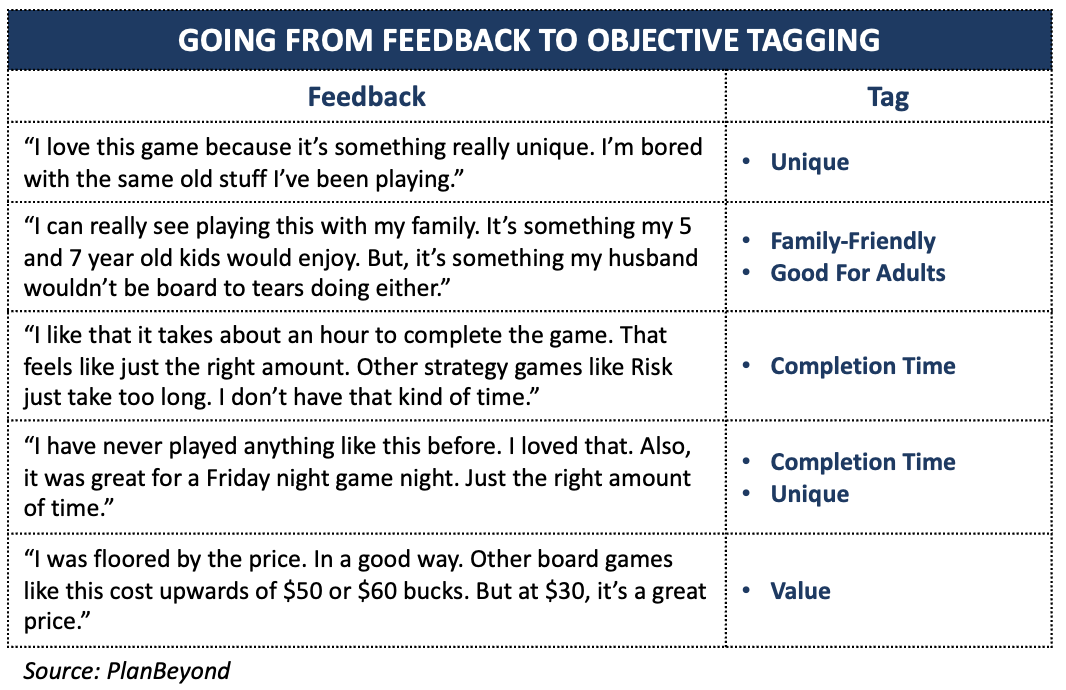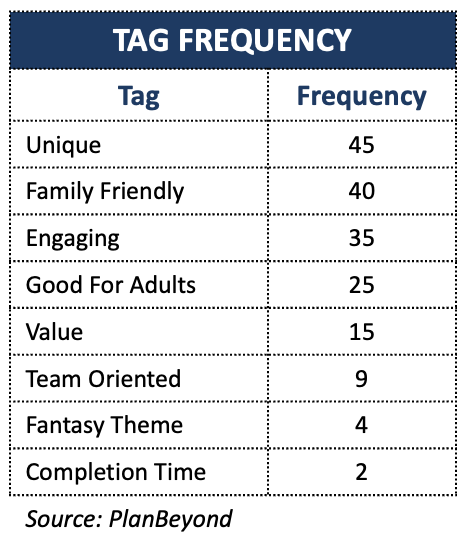Interviews or open-ended responses are unbelievably useful ways to collect rich, nuanced feedback. This data opens your eyes to ideas, challenges, pain points, or roadblocks customers have. And, in doing so, gives you needed insights into how to better build your business, brand, or products to meet market needs.
But, the very thing that makes it so valuable also makes it challenging: it yields unstructured, free-form data that can’t easily be aggregated.
That doesn’t mean don’t do it. Far from! Rather, it means we must apply systemic, objective approaches to analyzing the data to see those business-critical trends.
Why You Need To Embrace Unstructured Interview Data
We run across a variety of contexts where it’s necessary to make sense of unstructured feedback. Here are just a few examples:
- Early Product Concept Testing: When you’re in the earliest stages of testing new products or features, you don’t know how consumers will respond. Interviews and open-ended feedback are the best way to collect perceptions. However, you need a clear approach for deciphering customer perceptions.
- Product Appeal Questions In Surveys: It’s not uncommon in surveys to include a few open-ended questions. We typically see this when asking survey respondents what they do or do not like about something. It’s a great way to get a lot of feedback quickly. However, that large amount of feedback means you need a streamlined way to find patterns.
- Customer Satisfaction Feedback: Vendors frequently ask customers to share information about their experiences. You don’t know if this will be positive or negative feedback, let alone the nature of what they will share. You’ll need a way to compile that feedback to share it across product, operations, and customer service teams.
Essentially, when we want to give respondents the freedom to respond how they want to respond, we have to rely on open-ended feedback. It’s a treasure trove of information. However, we need to process it in an objective way to make it actionable.
Finding Patterns In Interview Research Using Tags
Making sense of open-ended feedback comes down to looking for clear patterns across the data. Specifically, when we talk about finding patterns in interview data, we’re usually talking about something called interview coding or tagging. This is an objective process for reviewing pieces of your data and categorizing it into distinct themes or topics. In essence, it takes unstructured information and provides a way to structure it so that it can be measured.
There are a few core reasons we do this:
- Quantify the Qualitative: The open-ended nature of interviews makes it hard to see patterns or trends. However, by assigning tags or codes, you can sum up those tags and see what keeps popping up again and again.
- Objective Process For Entire Team: With structured tags, anyone on your team can assign tags. They have agreed-upon categories which makes it easy to review feedback and assign it unique tags.
With this in mind, let’s look at two ways to create tags.
1. Creating Tags - The Bottoms Up Approach
The bottoms up approach says let the data guide your tags. You start by reviewing individual pieces of feedback. For each one, assign it unique themes or tags. As you go through 20-30 additional pieces of feedback, keep repeating this process.
You’re left with high-level themes or ideas that will likely recur throughout the rest of your feedback. At this point, you look to see if any tags look redundant. If so, consolidate them so you have a clean set of tags to use for coding the rest of your research.
When To Use This Approach: Use the bottoms up approach to tagging and finding patterns in your interview research when you are in early exploratory phases. When you don’t know what patterns you’ll find, this open-ended approach will help structure your tag process.
2. Creating Tags - The Top Down Approach
The top down approach says start off with key themes or tags. As you go through each piece of feedback, assign it one or more of your tags. Keep doing this for each and every piece of your feedback.
Once complete, your feedback is tagged with the specific themes of initial interest.
When To Use This Approach: Use the top down approach approach to tagging and finding patterns in your interview research when you have distinct themes you want to explore. This assumes you have a strong grasp of what you’re examining and need examples in your data to best explore key themes.
That said, it’s not uncommon to use a mix of both approaches. You likely enter into your feedback with themes you expect. But, you’re likely also open to seeing if other themes emerge. By marrying the two you often get the best of both worlds.
Finding Patterns In Interview Research In Action
Ready to see this in action? Let’s pretend we’re doing research for a new board game product. One of our clients’ goals is to create a game that is likable but also unique to the market.
With that product goal in mind, let’s pretend we ask users to tell us about what they liked when playing the game. You can see some of the mocked up responses to the right. Next to each response is at least one code, sometimes more.


Once each piece of feedback is coded, we then sum up the number of times each code is mentioned. We then get a frequency table like what you see on the left.
What does this show us? For starters, our test group found that the game was truly unique. It looks like our clients did achieve that objective. Also, many note that it is engaging, another client goal.
Interestingly, a large number cite it as family friendly. This is neither good nor bad at face value. However, it gives our client a chance to determine if this is something they want. Do they want to position this is a family friendly game, and therefore compete in that category? Or, did they hope for a more adult oriented game? If so, the codes show us that it doesn’t hit that mark.
Next Steps After Finding Interview Research Themes
We like to say that no one is looking for patterns in interview research just for fun. There are always key business or learning objectives at-hand. What this means is you must address those objectives using this new-found structured data.
Here are just a few of the typical questions we hear going into any interview or open-ended feedback project:
- Does the product or service meet expectations?
- Are consumers identifying positive elements you didn’t expect?
- Is there a problem / concern / issue you didn’t anticipate?
- Does it appeal to certain groups but not others?
- Are there barriers to usage?
Thanks to the coding process, which looks for patterns in our interview research and aggregates it into quantifiable data, we have an objective approach for answering these questions.






